If you want to learn more about Texas ranching and pioneer life on the western frontier, a visit to the National Ranching Heritage Center in Lubbock Texas is where you what you want to add to your Texas trip planner. The National Ranching Heritage Center is a magnificent museum that is well maintained and extremely informative. If you love Texas pioneer history then this venue is a must stop. This is one of the best Lubbock attractions you’ll entirely enjoy.
Thank you for reading this post, don't forget to subscribe!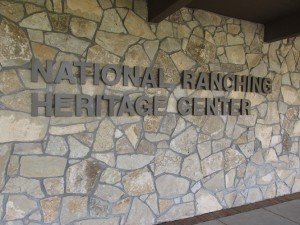
The National Ranching Heritage Center was dedicated in 1976 however the planning, the securing of financial resources and the gathering of western, ranch and pioneer exhibits including historic structures took place over the prior decade.
What to See
Located on the north boundary of the Texas Tech University campus in Lubbock, this amazing western museum comprising thirty acres features about fifty buildings that include a schoolhouse, barns, and very well preserved houses, etc. There are thirty-eight ranch structures. Each of them have been authentically and historically restored and furnished. Many of the ranch buildings are from history’s most important ranches. The buildings date from the late 1800’s to the mid twentieth century. The homesteads on display date from the time that the panhandle of Texas was settled and it’s pretty easy to appreciate what these settlers went through when you visit.
The photo below is the Hedwig’s Hill Dogtrot House that was originally built in Mason County Texas near the Llano River. This house was built as two log cabins under a common roof separated by a breezeway called a dogtrot. This architecture was very common on the frontier.
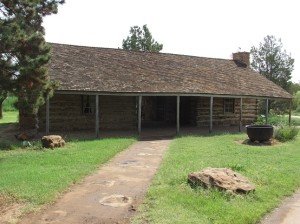
Also at the museum is a large collection of western art and ranching artifacts. You’ll also view nearly 200 vintage and antique firearms and about 1,000 pairs of spurs.
The National Ranching Heritage Center hosts several events throughout the year. Included is a chuck wagon dinner and a concert during the spring. During the summer are fiddle dances and an event named “Candlelight at the Ranch” in December. As an interesting side note, Texas rancher Charles Goodnight was credited with developing the first chuck wagon. Goodnight reportedly built his chuck wagon using a Civil War surplus Studebaker wagon.
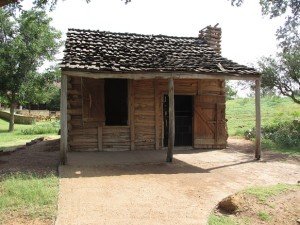
The National Ranching Heritage Center sponsors the Junior Rough Riders, a membership organization for youths. Some of the programs that are part of the membership are coloring contests, summer youth classes, children’s library, Heritage Halloween and Ranch Day.
As of this writing, the National Ranching Heritage Center is open seven days a week. M-Sat 10A-5P. Sun 1-5P. The Historical Park closes at 4P every day. The National Ranching Heritage Center is located at 3121 4th St., at the north boundary of the Texas Tech University campus in Lubbock Texas.
The Ranches of the Texas Panhandle
It is quite appropriate that a large ranching museum is located in Lubbock Texas. It just so happens that some of the largest and more famous ranches in our country were in the Texas Panhandle area of the state.
Among these would be the XIT and the JA. The XIT, established during the early 1880’s, and the money paid for it by investors financed the building of the Texas State Capital Building in Austin. That same building, constructed of local pink granite, is still today the state capital building of Texas.
The JA Ranch was established by veteran rancher Charles Goodnight and John Adair. The ranch was centered in the Palo Duro Canyon area of the Panhandle. Goodnight is often referred to as the Father of the Texas Panhandle.
You may also enjoy the Trips Into History articles on the links below…
The Famous Ranches of Old Texas
Cattle Drives and Cowboys / What It Was Really Like
The Wells Fargo Stagecoach / Photos and History
On our Western Trips site you might enjoy our article and visit to the Panhandle Plains Museum in Canyon, Texas.
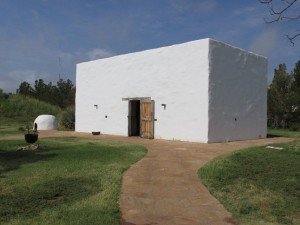
Historic Frontier Structures
As mentioned above, the National Ranching Heritage Center exhibits dozens of historic buildings and structures. This makes it one of the most unique of Lubbock attractions.
Among those featured in this article is the Hedwig’s Hill Dogtrot House explained above.
Also shown in a photo above is the El Capote Cabin.from the period 1836 to 1845. This was the period of the Republic of Texas. This cabin was located in what is now Guadalupe County, Texas. Construction material included winged elm logs chinked with mud from a nearby stream bed. The roof material was hand split pecan shakes and the floor of the cabin was compacted earth which was very common in that period and in that locale. This architecture was very prevalent in early frontier cabins.
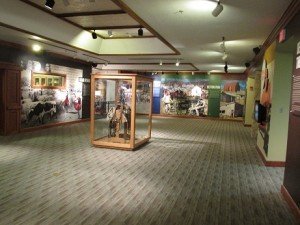
The Los Corralito’s structure shown above was a fortified home from Zapata County Texas. The structure is distinctive with it’s 33 inch thick walls, one door and no windows and six gun ports for defense.
It’s thought that Los Corralito’s rancho might have been the earliest rancho in Texas with standing structures. The walls of this defensive building were made of cut sandstone along with mud and mortar. The term los corralito’s in Spanish means “little corrals“.
(Article and photos copyright 2014 Trips Into History)
